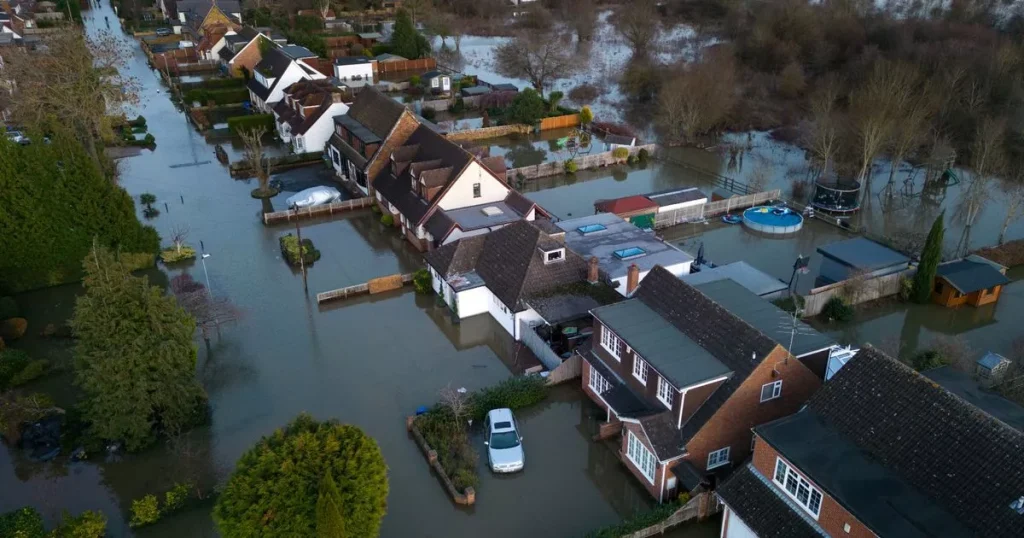‘Golden rule’ you must follow to claim on insurance if your home is damaged by storms or floods

Temperatures plummeting. Storms lashing the land. Mulled wine freezing at the Christmas market.
Yes, it’s winter and the weather is doing its usual thing. If your home is damaged by flooding, as my partners was this week, or your pipes burst, or heavy snow makes your carport keel over, it can sometimes be a frustrating process to get the repairs done.
With the weather being so unpredictable, don’t wait for a disaster to occur. Check your insurance policy to see what you’re covered for if your home is damaged. But if disaster strikes, here’s my guide on how to make a claim… and get things sorted out as quickly as possible.
The golden rule
If your home is damaged as a result of a storm, flood or snow, then the process can seem overwhelming. This is often because of the sheer number of people who are involved in assessing and repairing your home. So let’s keep things simple. Your contract is with your insurer. So no matter who they contract to sort out your claim, direct all of your questions, concerns and complaints to them.
Aldi is selling every ingredient you need for Christmas dinner costing £1.91
Thousands of families eligible for £460 energy help after Winter Fuel Payment axe
How storm damage claims begin
Insurance companies initially send out ‘loss adjusters’ to assess the damage to your property. Loss adjusters decide what repairs need to be done to your property as a priority, along with providing an overview of everything that will need to be done to return your home to as close as it was before the incident as possible.
Loss adjusters are different to "loss assessors" who are hired by you to manage the claim so you get the maximum payout, in return for a fee. Insurance companies usually get the loss adjusters out rapidly when there is a storm affecting many properties in your area. However, if it’s a major disaster there may be some delays.
Help speed up the process by noting down all the problems you’ve identified, along with damaged contents and fittings. I know this is distressing, but the faster you get this done, the faster your claim gets resolved.
What to say when you make a claim
Don’t wait until you are caught out by a weather disaster. Email your policy to yourself so you can find it quickly and save the emergency/claims number and policy number to your phone. As soon as an event occurs, call the insurance company. If the problem is ongoing you can add to it later.
If weather forecasts suggest floods or storms are likely to continue your insurer may be able to offer some practical tips. Try to get as much information as possible. Record keeping is vital with insurance companies, so make a note of when you called and who you spoke to.
Keep a record of any costs you’ve incurred during the initial storm damage, including hotel bills and emergency repair works. However, if you can, get these authorised in advance by the insurance company. Here’s my home insurance claim checklist:
- What they will do to return the property to normal (repairs, structural work, contents).
- Accommodation if the property is uninhabitable.
- Timescales.
- Special requirements, like medical conditions or disabilities and age, that might mean you need prioritising.
- Names and contact details of all contractors.
- Security information.
Don’t use your own contractors unless the insurance company has given permission for them to work on the property. They’ll need to sign off the quote and authorise the work. You can ask for your own contractors if you think they’ll do a better job, but you might have to pay the difference if they are too pricy.
The most important thing is to find out how you’ll be kept informed of progress. Ask if there’s a number to call for updates. Storm claims can be complex and may take a long time to resolve fully. So, make sure you understand everything that’s going on.
Why does it take so long to sort out storm claims?
If your property has been structurally damaged, it can take a long time to repair all of the damage. That’s because your home may need to be dried out first before the full nature of the repairs can be assessed. The insurer might insist that anti-flooding measures are included too if you are in an ‘at risk area’. There can also be a range of complications around everything from the electrics to the roof supports.
As a consequence, you may find yourself stuck in less than glamorous alternative accommodation for a prolonged period. You can object to this if it’s not suitable.
What about contractor disputes?
Loss adjusters, builders, electricians, plasters, assessors, plumbers. A lot of people might be tramping through your home and that can often lead to disputes. I hear loads of complaints about contractors sneaking off early, working on multiple different homes at once and not having the right materials.
Alternatively, you might fundamentally disagree with the assessment of the damage, value of the claim or the contractors who are hired to carry out the work. Remember the golden rule: If there’s a problem, go to your insurer.
How to complain
If you aren’t happy with any aspect of an ongoing claim, you need to make a formal complaint. Write down everything that’s gone wrong and if you have an idea of what you want, spell that out too. I’d recommend getting some quotes from other contractors in the area if the repairs aren’t up to standard. Speak to the insurance underwriter and see if they are willing to replace the contractor based on your complaint.
If you are still unhappy with the resolution, the good news is you don’t need to wait until the repairs are done to take things further. Once the complaint is outstanding over eight weeks, you can take your complaint to the free Financial Ombudsman Service (FOS).
As I often say in this column, the ombudsman has the power to tell the insurer how to sort out the complaint, from cash and compensation to ensuring the repairs are carried out effectively.
Wear and tear claim rejections
One of the biggest reader gripes is claims rejected due to "wear and tear". This is a term that means the insurer recognises that damage has occurred but argues that the storm, snow or flooding is not directly responsible for the incident you are claiming about.
Turn detective to beat these rejections. Dig out photos showing that your home was not in poor condition. If your neighbours have had similar problems, get proof from them too. Insurance companies look at the weather in your local area from official sources, to assess if the damage occurred as a result of a recognised storm.
Your policy should explain how this is defined. Don’t get bogged down by the wording though – go to the ombudsman if you are unhappy. Sadly, many insurers try to argue that storms or floods were not ‘severe’ enough or didn’t meet their definitions. This can lead to ridiculous situations. It’s up to them to prove that the storm that affected you wasn’t severe enough – and the ombudsman often upholds complaints about unfair assessments of weather damage.
Wear and tear can be subjective. If your roof is missing tiles, then damage to it may be as a result of wear and tear. But how many tiles? Was the roof leaking? When did you last have the roof assessed? These are the questions you should ask yourself in order to counter unfair claim rejections.
- Martyn James is a leading consumer rights campaigner, TV and radio broadcaster and journalist
Weekend Wishlist: Winter knitwear, party dresses, skincare essentials and more



